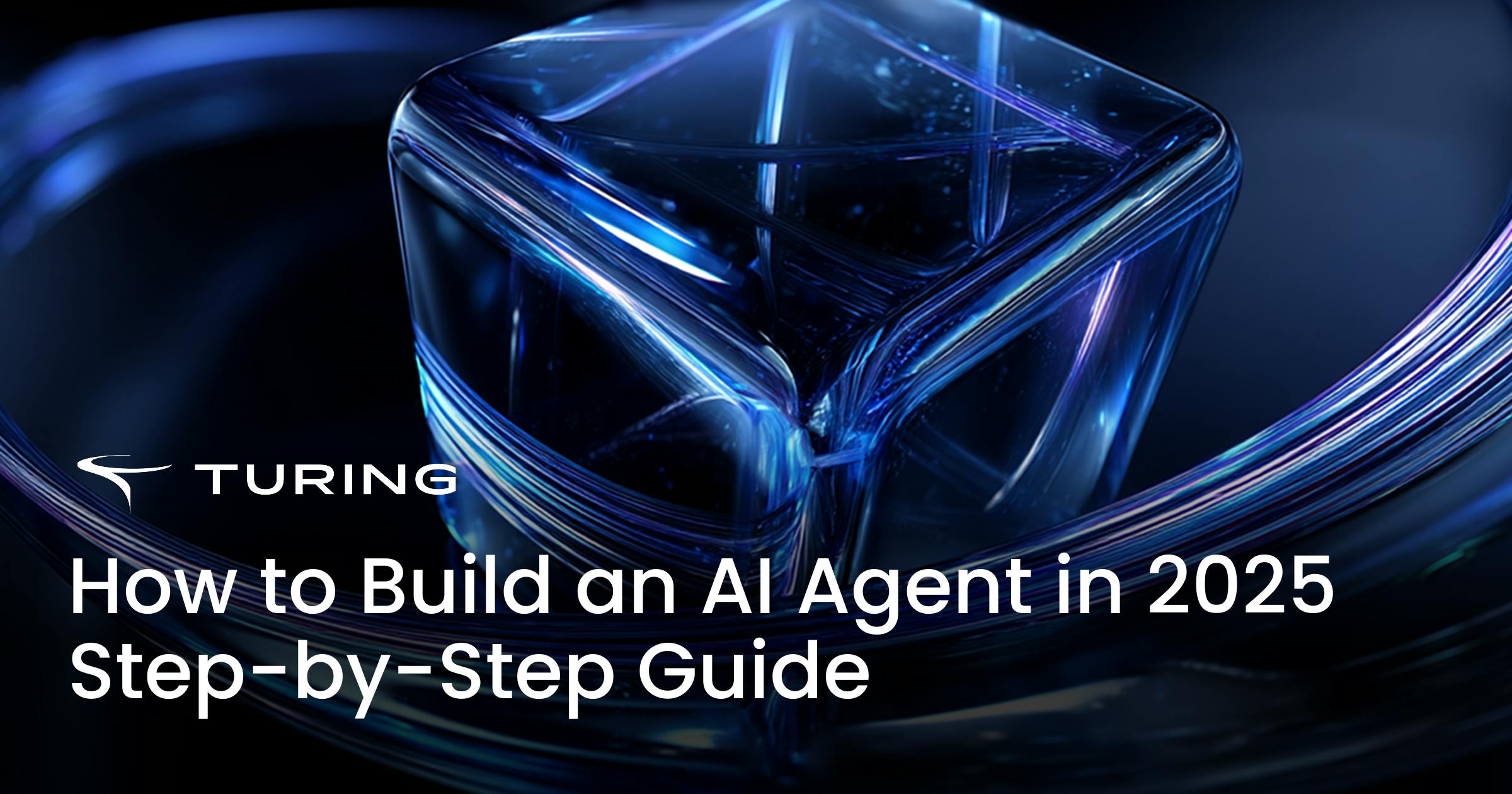How to Build an AI Agent | A Step-by-Step Guide

Anjali Chaudhary
•8 min read
- AI/ML

In 2025, AI agents aren’t just a concept—they’re a competitive edge.
From virtual researchers summarizing technical papers in seconds to artificial intelligence (AI) teammates autonomously triaging support tickets, agents are transforming how enterprises operate, innovate, and scale. They’re not just smarter chatbots. They’re self-directed systems with the autonomy to perceive, reason, and act—continuously learning as they go.
This isn’t just industry optimism—it’s a view echoed by today’s most influential AI leaders. "We believe that, in 2025, we may see the first AI agents 'join the workforce' and materially change the output of companies," said Sam Altman, CEO of OpenAI. OpenAI’s recent release of Operator, an autonomous agent capable of real-world web actions, signals how fast this future is arriving.
The question is no longer if AI agents will become essential. It’s who will build them best—and fastest.
This guide is your blueprint. Whether you're a systems architect exploring agent orchestration or a CTO seeking practical ways to scale intelligent automation, you'll find actionable steps, frameworks, and strategies to build AI agents that don’t just function—but deliver measurable impact.
What is an AI agent?
An AI agent is an autonomous system that perceives its environment, processes information, and takes goal-oriented actions with minimal human intervention. These agents use a combination of machine learning (ML), natural language processing (NLP), and decision-making algorithms to continuously learn and optimize outcomes.
Modern AI agents blend several layers of intelligence:
- Perception: Collecting data via APIs, sensors, or user input.
- Reasoning: Using models—typically powered by machine learning or large language models (LLMs)—to interpret data and decide on actions.
- Action: Executing workflows, generating outputs, or invoking other tools/services.
- Adaptation: Learning from feedback and improving through retraining or reinforcement learning.
How to build an AI agent: 6 Steps to follow
Building a production-grade AI agent is a multi-stage process that integrates software engineering, machine learning, architecture design, and ethical deployment practices.
Step 1. Define the agent’s objective and boundaries
Every AI agent starts with a well-defined problem. Are you building a customer support assistant that triages tickets, a sales bot that pre-qualifies leads, or a code reviewer for an engineering team?
Beyond function, define:
- Scope: Is the agent reactive (responds to queries) or proactive (initiates actions)?
- Success metrics: Accuracy, response time, goal completion rate, or user satisfaction?
- Environment: Will it operate inside Slack, a browser, an internal dashboard, or across APIs?
Clear boundaries protect against scope creep and guide every downstream decision.
Step 2. Choose the right technology stack
The tech stack you choose will determine how adaptable, scalable, and efficient your agent becomes. “The most successful agent deployments aren’t using complex frameworks—they’re using simple, composable patterns.” — Anthropic
Core components include:
- Programming languages:
a. Python: Most popular for agents, with huge AI/ML libraries.
b. JavaScript/Node.js: Great for web integration.
c. C++/Java: Used for performance-critical tasks (e.g. robotics). - Modeling frameworks: TensorFlow, PyTorch for custom ML; LangChain or Autogen for agent orchestration.
- Data infrastructure: MongoDB for storage; Apache Kafka for real-time streaming; Snowflake for enterprise datasets.
- Hosting: Cloud-first (AWS, Azure, GCP) is the standard; edge deployment is rising for latency-sensitive use cases.
- Agent platforms: Open-source AI agent frameworks like crewAI and LlamaIndex simplify setup for multi-agent systems or context-aware tasks.
The tech stack should be flexible—so your agent isn’t tied to one provider like OpenAI or Anthropic and can easily switch between models.
Step 3. Assemble your development team
AI agents are inherently cross-functional. Building one from scratch requires collaboration across:
- Machine learning engineers – for model design and fine-tuning.
- Data scientists – for preprocessing, labeling, and pipeline optimization.
- Software engineers – for system integration and backend logic.
- UX designers – to align agent interactions with user expectations.
- DevOps – to manage deployment, scaling, and continuous monitoring.
Outsourcing certain functions (e.g., model training or data engineering) can reduce overhead—just ensure you retain control of your core logic and data pipeline.
Step 4. Prepare high-quality, task-specific data
Your AI agent is only as good as the data it's trained on. For goal-oriented agents, data preparation isn’t optional—it’s foundational.
Key considerations:
- Aggregate data from structured (CRM, ERP) and unstructured sources (emails, documents, chats).
- Cleanse and normalize data to reduce bias and improve consistency.
- Maintain logs and labels for supervised learning or reinforcement models.
- Create synthetic datasets to train for edge cases or rare behaviors.
Plan early for data privacy and governance—especially for customer-facing agents or those operating in regulated industries.
Step 5. Architect for modularity and feedback
Modular architecture is a game-changer. It allows each component—input parsing, reasoning, action execution, logging—to evolve independently.
Key features of smart architecture:
- Concurrent task design: Let agents perform multiple operations simultaneously.
- Reusable components: Common functions (e.g., summarization, classification) should live in shared libraries.
- Feedback loops: Enable users and systems to rate responses, correct errors, or re-route tasks.
This isn’t just good engineering—it’s how agents improve over time without being rebuilt from scratch.
Step 6. Implement, train, and refine the agent
Start with:
- Prompt engineering: Define clear, modular instruction blocks.
- API integrations: Connect to internal systems for real-time action execution.
- ML model selection: Use pretrained LLMs where possible; fine-tune for niche use cases.
Use iterative refinement:
- Test different prompts, memory strategies, and retriever models.
- Evaluate against task benchmarks (e.g., MMLU, GSM8K) or custom KPIs.
- Implement evaluator-optimizer workflows for reinforcement-based improvements.
Approaches to building an AI agent: Build from scratch or use frameworks?
When developing AI agents, one of the first strategic decisions you’ll face is whether to build from the ground up—or to accelerate development using an existing framework.
There’s no one-size-fits-all answer. Your choice should depend on your organization’s goals, timeline, available expertise, and need for control. Below, we break down both approaches to help guide your decision.
Option A: Build from scratch
Best for:
- Enterprises with unique workflows or strict compliance needs
- Use cases involving proprietary datasets or internal knowledge graphs
- Organizations with in-house AI/ML engineering talent
Why choose this route? Building from scratch offers complete flexibility. You define the architecture, tailor the prompting strategy, and determine how the agent will interact with your data, APIs, and logic layers. This level of precision is ideal for mission-critical systems, such as financial forecasting agents, internal research tools, or regulated enterprise applications—where performance, explainability, and trust are non-negotiable.
Pros:
- Full customization and IP control
- Optimized performance for domain-specific tasks
- Easier to enforce privacy, compliance, and security protocols
Cons:
- Longer time to value
- Requires deep technical expertise and ongoing maintenance
- Higher upfront development cost
If you're building a next-gen AI teammate to operate inside a proprietary ecosystem—or need total control over how it learns, reasons, and executes—this path may be the right fit.
Option B: Use AI agent frameworks
Best for:
- Rapid prototyping and iteration
- Common enterprise workflows (support, onboarding, doc search)
- Leaner teams or those just starting their AI journey
AI agent frameworks dramatically reduce complexity. They come with prebuilt components like memory modules, tool routing, planning, and fallback logic, making them a good choice for quickly building production-ready agents—especially in environments where speed matters more than total customizability.
Frameworks also allow companies to experiment and scale iteratively, learning what works before investing in more bespoke architectures. If you're testing a use case or launching an internal proof of concept, a framework can help you get there faster—with enough flexibility to evolve over time.
Top frameworks in 2025:

Why are AI agents essential for modern enterprises?
AI agents aren’t just automation tools—they’re force multipliers. Their evolution marks a clear shift: from rigid, rule-based scripts to flexible, context-aware systems capable of adapting to nuanced workflows.
Still, AI leaders remain realistic about their current capabilities. "AI agents will become commonplace as people get used to having different types of AI assistants help them in their work," noted Yann LeCun, Chief AI Scientist at Meta, during CES 2025. But he also emphasized that most will remain "bots trained on certain tasks, not truly smart AI assistants that can perform activities from scratch without getting specific training."
This perspective is essential: today’s AI agents are most effective when designed with purpose-built intelligence, not when treated as general-purpose problem solvers. Their strength lies in precision, not breadth.
When integrated well, AI agents deliver measurable business outcomes:
- Operational scale: One agent can replace hundreds of manual interactions.
- 24/7 responsiveness: No delays, no fatigue.
- Cost reduction: Automate tier-1 support, internal ops, and decision pipelines.
- Personalization: Use context, history, and preferences to adapt in real time.
- Data intelligence: Agents don’t just act—they learn and improve with each task.
Across industries, AI agents are already delivering tangible value:
- Capital One’s Eno: Manages account inquiries and transaction alerts.
- Amazon’s Alexa: Combines multimodal input with decision logic for home automation and shopping.
- Internal research agents: Used by Fortune 500 firms to distill competitive insights or summarize technical papers.
Whether you’re in fintech, retail, SaaS, or research, AI agents are emerging as the connective tissue of modern enterprise systems—not just performing tasks, but transforming how they’re done.
Challenges in building AI agents
- Data quality and availability
Poor data leads to unreliable decisions. Use synthetic data, crowd-labeled sets, and robust filters to minimize gaps. - Real-time execution
Balancing speed and accuracy is tough. Optimize model size and leverage edge computing for latency-sensitive workflows. - Ethical and safety considerations
Agents must be transparent, explainable, and fair. Use feedback loops and auditing tools to track decision-making. - Cost control
LLM usage and infrastructure scale fast. Use budget monitoring tools like Google Cloud Cost Insights and trigger-based model selection to stay lean. - Ongoing maintenance
Agents must evolve. Plan for weekly prompt reviews, monthly retraining cycles, and quarterly architecture audits.
Final thoughts
AI agents are no longer an experimental frontier. They’re becoming core infrastructure for companies looking to automate intelligently, learn continuously, and scale without ceiling.
Industry thought leaders like Andrew Ng believe we’re on the cusp of a structural shift. "AI agents and agentic workflows will drive massive AI progress," he noted in a recent article, pointing to reflection, tool use, and multi-agent collaboration as key design patterns for the next era of innovation.
To build agents that outperform—not just operate—enterprises must start with sound architecture, grounded use cases, and flexible tooling. That’s where Turing Intelligence comes in. By integrating human expertise with AI, Turing Intelligence solves complex challenges across industries by helping organizations:
- Build, optimize, and deploy high-performing AI agents
- Optimize deployment across secure, scalable environments
- Enable human-in-the-loop governance for responsible automation
Turing doesn’t just power research—it bridges research and production to help your agents go live, fast—and stay smart.
Want to accelerate your business with AI?
Talk to one of our solutions architects and get a complimentary GenAI advisory session.
Get Started
Author
Anjali Chaudhary
Anjali is an engineer-turned-writer, editor, and team lead with extensive experience in writing blogs, guest posts, website content, social media content, and more.
Share this post

Want to accelerate your business with AI?
Talk to one of our solutions architects and get a complimentary GenAI advisory session.
Get Started